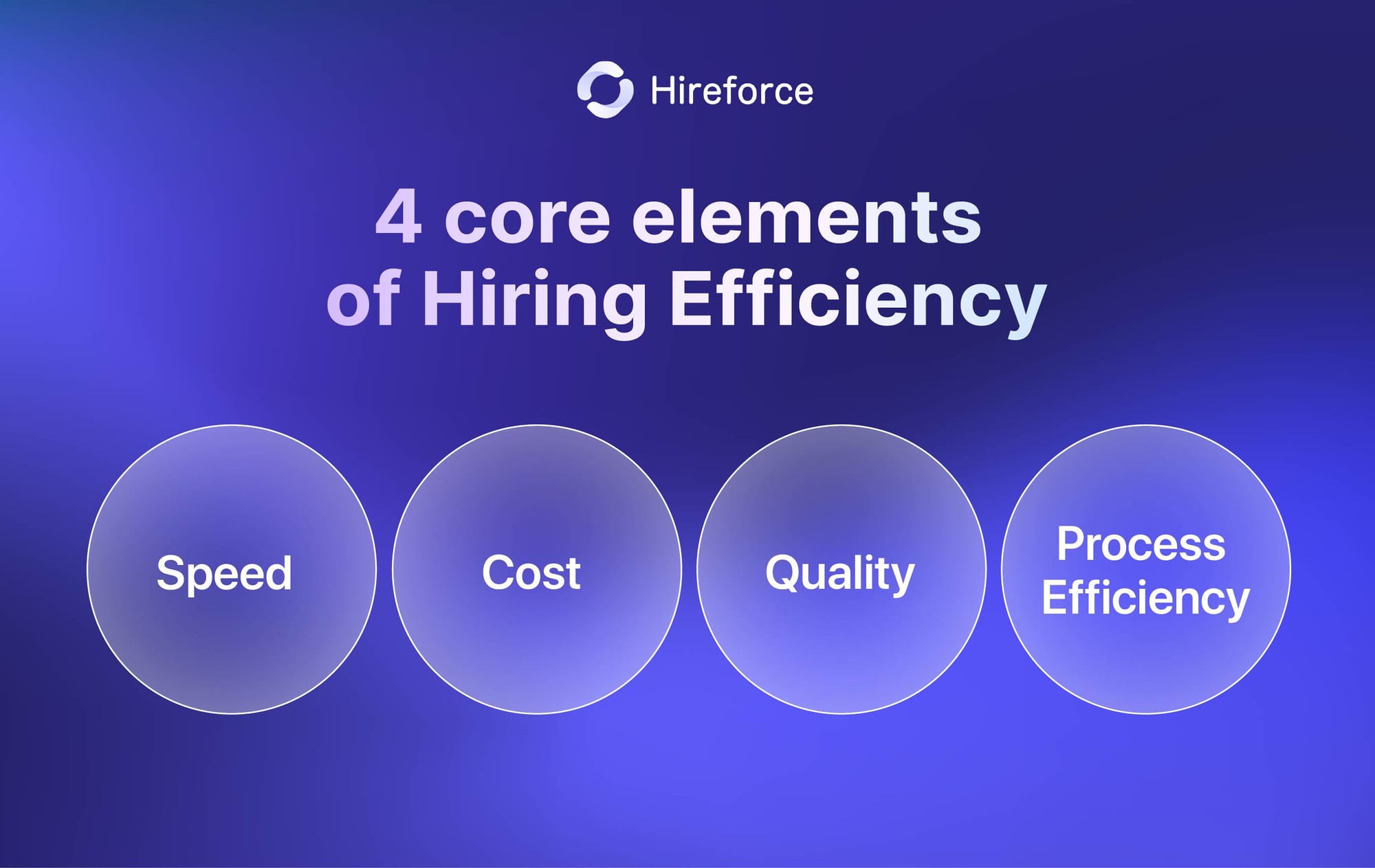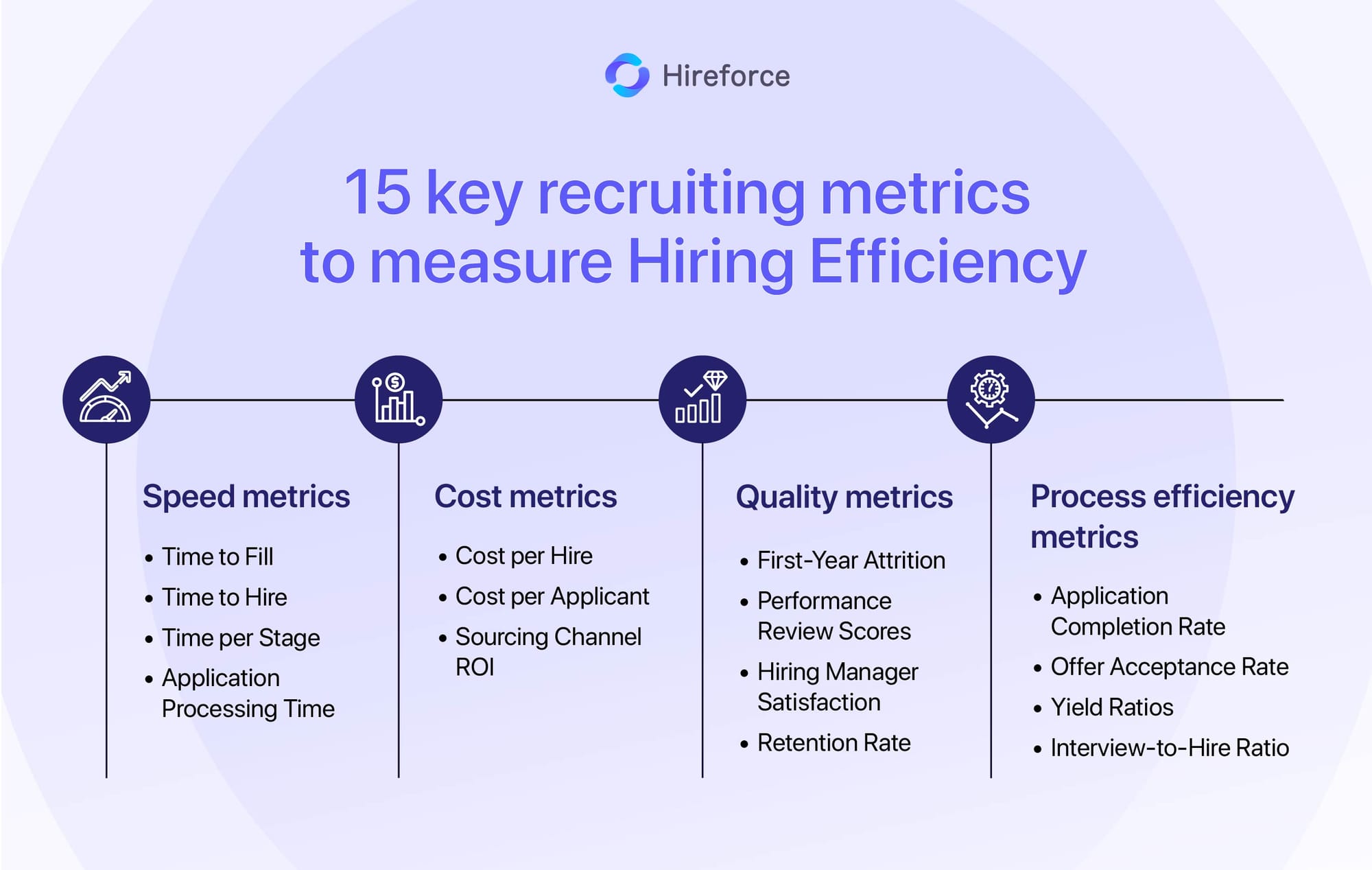Have you ever been so struggling to fill roles quickly and while maintaining candidate quality? In current demanding talent market, hiring efficiency is no longer a luxury, but a necessity for competitive advantage. Many recruiters face pressure to accelerate hiring without sacrificing quality, yet lack a clear framework for measuring and optimizing their processes.
This guide from Hireforce provides you with actionable strategies to understand, measure, and significantly improve hiring efficiency, transform your recruitment from a bottleneck into a streamlined talent engine.
What is Hiring Efficiency? Decoding core elements for Recruitment Success
Hiring efficiency in recruitment is not just about speed – it's about strategically optimizing your entire talent acquisition process to achieve the best outcomes with available resources. True efficiency means striking a balance across key elements to build a high-performing talent engine.
There are 4 core elements that define hiring efficiency, and mastering them is key to recruitment success. It's not about maximizing just one, but rather achieving equilibrium across all:
- Speed: The velocity of your hiring process, measured by how quickly you fill roles. Essential for minimizing time-to-productivity.
- Cost-Effectiveness: Recruiting within budget and maximizing ROI from your recruitment investments. Crucial for resource optimization.
- Quality of Hire: Attracting and selecting top performers who contribute long-term value. Paramount for organizational success.
- Process Efficiency (Candidate Experience): Ensuring a positive journey for all applicants, strengthening your employer brand. Vital for future talent pipelines.
The key to unlocking true hiring efficiency lies in strategically balancing these 4 interconnected elements. By understanding and optimizing each facet, you can create a recruitment process that is not only fast and affordable, but also consistently delivers high-quality hires and a positive experience for every candidate.

Why Hiring Efficiency is non-negotiable to you?
Hiring efficiency has transitioned from a "nice-to-have" to a "must-have" for organizational survival and success. Inefficient hiring is no longer just an HR problem – it's a business risk. But why is that? The answer lies in the profound and multifaceted benefits it delivers in a world characterized by constant change and intense talent competition.
1. Gain a competitive advantage in the talent market
The talent market is fiercely competitive, and efficient hiring processes allow you to move faster than your rivals, secure top candidates before they are snatched up by more agile organizations. In a candidate-driven market, speed and responsiveness are paramount to attracting and winning over high-demand talent.
2. Considerably reduce costs & maximize recruitment ROI
Extended time-to-fill inflates advertising costs, agency fees, and internal recruiter hours, while simultaneously prolonging vacancy costs. Hiring efficiency directly attacks these financial concerns. Streamlined processes, optimized sourcing, and faster hiring cycles equal to significant cost savings and a dramatically improved ROI for every recruitment dollar spent.
» Maximizing ROI in Recruitment with Hireforce
3. Accelerate Time-to-Productivity and boost business agility
Lengthy hiring processes will delay projects, strain existing teams, and hinder organizational growth. Having an efficient hiring system allow you to minimize vacancy periods, ensure new hires onboard and contribute meaningfully to business objectives faster.
This speed translates to increased organizational agility, enabling your company to respond swiftly to market changes, capitalize on new opportunities, and maintain project momentum without talent-driven delays.
4. Elevate candidate experience and employer branding
Candidate experience is currently employer brand. A slow, cumbersome, or opaque hiring process leaves a negative impression, damaging your reputation and deterring future talent. Efficient hiring shows your respect for candidates' time, then creates a positive experience. This not only attracts better candidates but also transforms applicants into brand advocates, expanding your talent pipeline organically.
5. Enable scalability and sustainable growth in a volatile market
Modern businesses must be agile and scalable to thrive in unpredictable markets. Inefficient hiring becomes a critical bottleneck when rapid growth or strategic pivots demand swift talent acquisition. Hiring efficiency provides the scalability needed to quickly ramp up teams, adapt to changing skill demands, and sustain growth trajectories, regardless of market volatility.

15 key recruiting metrics to measure Hiring Efficiency
To effectively measure and improve hiring efficiency, you need to track the right metrics. Focusing on a select set of key indicators will provide a clear, data-driven understanding of your recruitment process performance.
Hireforce’s categorized these essential metrics into four core areas that directly reflect the elements of hiring efficiency we discussed: Speed, Cost, Quality, and Process Efficiency.
1. Speed metrics
Prolonged hiring cycles create bottlenecks and delays, what’s why time directly impact productivity and competitiveness. These metrics focus on measuring the velocity of your recruitment process:
- Time to Fill: The duration from job posting to job offer acceptance. Indicates overall hiring cycle speed.
- Time to Hire: The duration from candidate application to job offer acceptance. Measures speed from candidate perspective.
- Time per Stage: The average time candidates spend in each recruitment stage (application, screening, interview, etc.). Pinpoints bottlenecks in the process.
- Application Processing Time: The time taken to review and process incoming applications. Reveals efficiency of initial screening stage.
2. Cost metrics
From a budgetary perspective, recruitment is an investment, and these metrics help you track expenses and maximize your return:
- Cost per Hire: The total recruitment cost divided by the number of hires. Provides overall cost-effectiveness of hiring.
- Cost per Applicant: The total recruitment cost divided by the number of applicants. Measures efficiency of candidate attraction efforts.
- Sourcing Channel ROI: Return on Investment for each sourcing channel (e.g., job boards, LinkedIn, referrals). Identifies most cost-effective sources.
3. Quality metrics
While harder to measure directly and immediately, quality metrics are paramount for long-term hiring efficiency. Hiring the wrong person, even quickly and cheaply, is considered as inefficiency be default. These metrics act as indicators of hire quality:
- First-Year Attrition: The percentage of new hires who leave within their first year. Signals potential mismatches or onboarding issues.
- Performance Review Scores (for new hires): Performance ratings of new hires after a set period (e.g., 6 months, 1 year). Indicates initial performance level.
- Hiring Manager Satisfaction: Hiring managers' feedback on the quality of hires and the recruitment process. Reflects internal stakeholder satisfaction with hiring outcomes.
- Retention Rate (long-term): Overall employee retention rates, potentially segmented by hire source or recruitment process. Long-term indicator of overall hiring quality and fit.
4. Process efficiency metrics
Process efficiency metrics focus on the smooth operation of your recruitment funnel itself. Optimizing these metrics enhances overall hiring efficiency by reducing candidate drop-off and improving conversion rates at each stage:
- Application Completion Rate: The percentage of candidates who start and complete the application process. Reveals user-friendliness of application process.
- Offer Acceptance Rate: The percentage of job offers extended that are accepted. Indicates offer competitiveness and candidate desirability.
- Yield Ratios: Conversion rates between different stages of the funnel (e.g., Applications to Interviews, Interviews to Offers). Pinpoints bottlenecks and areas for process optimization.
- Interview-to-Hire Ratio: The number of interviews conducted per hire. Indicates efficiency of interview and selection process.
» Ultimate Guide to 40+ Recruitment Metrics: Track your Hiring Success at Every Stage
7 expert tips to fortify Your Hiring Efficiency
1. Make your application process mobile-friendly & quick
You should seriously think mobile first, because so many candidates apply from their phones these days. If your application is clunky on mobile, you're losing people fast. The advice is keeping your application forms short and sweet, super easy to fill out on a phone, and you'll see way fewer people drop off mid-application and get a bigger, better pool of candidates.
2. Standardize your interview processes & implement structured interviews
This action can mitigate unconscious bias and enhance evaluation consistency. Your tip is creating a set of core questions for each role and use a simple scorecard to evaluate everyone fairly. This helps your team stay focused, compare candidates consistently, and make decisions quicker – and often fairer too.
3. Optimize sourcing channels & focus on high-yield sources
Diligent analysis of Source of Hire data and channel-specific conversion rates allows you to reallocate your resources towards platforms and methods that demonstrably deliver qualified candidates at a faster pace and lower cost, thereby maximizing sourcing ROI.
4. Leverage AI-powered ATS for screening & shortlisting
To speed up your candidate screening and shortlisting processes, you can strategically leverage AI-powered features within your Applicant Tracking System (ATS). Automated resume parsing, AI-driven skills matching, and intelligent candidate ranking algorithms significantly reduce your workload in early-stage filtering, accelerating candidate progression through the recruitment funnel.
» The Impact of Automation: Quantifiable Results for ATS
5. Automate communication & scheduling throughout the candidate journey
Thoroughly implementing this tip can help you enhance candidate experience and minimize administrative delays. Deploying automated email triggers for application confirmations, interview scheduling, and feedback updates considerably reduces your manual tasks, ensures timely candidate communication, and accelerates the overall recruitment timeline.
6. Prioritize transparent & timely communication with candidates
Doing this throughout all your recruitment stages will cultivate a positive candidate experience and maintain candidate engagement. By providing consistent updates on application status, interview timelines, and decision outcomes you will minimize candidate anxiety, reduce candidate drop-off due to perceived process delays, and strengthen employer brand perception.
7. Foster strong collaboration between recruiters & hiring managers for faster decisions
To accelerate decision-making and minimize bottlenecks, fostering robust collaboration between recruiters and hiring managers is critical for optimizing your hiring efficiency. Establishing clear means of communication, shared candidate feedback platforms, and joint participation in key decision points can let you streamline candidate evaluation, reduce back-and-forth delays, and ensure swift progression from interview to offer stages.

Key Takeaways
So, you're aiming for a recruitment process that's not just busy, but truly effective? That's the power of hiring efficiency. It’s about working smarter, not just harder, to build a talent engine that drives your organization forward. Let's quickly recap the essentials to make hiring efficiency your reality:
- Efficiency is balanced: Forget "fast hiring." True hiring efficiency balances speed, cost-effectiveness, quality hires, and a great candidate experience. It's about getting the right hires, effectively.
- Efficiency is essential: In today's talent landscape, hiring efficiency isn't optional, it's vital for staying competitive, controlling costs, boosting productivity, building your brand, and scaling for the future.
- Choose the right metrics: You only need to measure what matters! Track speed metrics, cost metrics, quality metrics, and process efficiency metrics to understand exactly how your hiring engine is performing and pinpoint areas to improve.
- Hireforce’s expert tips are your toolkit: Implement the our suggested 7 expert tips to accelerate your hiring performance and streamline your process. Action is key to transformation.
If you’re searching for a system that can actually make a difference in your hiring results, Hireforce ATS can be your solution. Our system provides the comprehensive support you need to dramatically boost your hiring efficiency. See what Hireforce ATS can do for you.




